🍦🍦🍦由于代码都是我自己敲出来调试的,所以可能不能一次更新那么多,大家见谅,不过因为我最近在备考机试,所以会拿出大量的时间在这上边,更新的会比较勤的~~~
目录
[🧊🧊🧊2.7 查找类问题](#🧊🧊🧊2.7 查找类问题)
[🥥例题:DreamJudge 1476](#🥥例题:DreamJudge 1476)
[🥥例题:DreamJudge 1477](#🥥例题:DreamJudge 1477)
[DreamJudge 1177 查找学生信息](#DreamJudge 1177 查找学生信息)
[DreamJudge 1388 查找 1](#DreamJudge 1388 查找 1)
[DreamJudge 1387 查找 - 北邮 🍰](#DreamJudge 1387 查找 - 北邮 🍰)
[DreamJudge 1383 查找第 K 小数](#DreamJudge 1383 查找第 K 小数)
[🧊🧊🧊2.8 贪心类问题](#🧊🧊🧊2.8 贪心类问题)
[🥥例题:DreamJudge 1478](#🥥例题:DreamJudge 1478)
[DreamJudge 1307 组队刷题 🍰](#DreamJudge 1307 组队刷题 🍰)
[DreamJudge 1347 To Fill or Not to Fill 🍰](#DreamJudge 1347 To Fill or Not to Fill 🍰)
[🧊🧊🧊2.9 链表类问题](#🧊🧊🧊2.9 链表类问题)
[🥥例题:DreamJudge 1081](#🥥例题:DreamJudge 1081)
[DreamJudge 1015 单链表](#DreamJudge 1015 单链表)
[DreamJudge 1018 击鼓传花](#DreamJudge 1018 击鼓传花)
[DreamJudge 1025 合并链表](#DreamJudge 1025 合并链表)
[DreamJudge 1405 遍历链表](#DreamJudge 1405 遍历链表)
🧊🧊🧊2.7 查找类问题
🥥题型总结:
- 数字查找: 给你一堆数字,让你在其中查找 x 是否存在( 如果 x 存在,请输出有几个)
- 字符串查找: 给你很多个字符串,让你在其中查找字符串 s 是否存在
当查询次数很多或数据量特别大的时候就不适合用顺序查找了。这类查找类题目,推荐使用map!
🥥例题:DreamJudge 1476

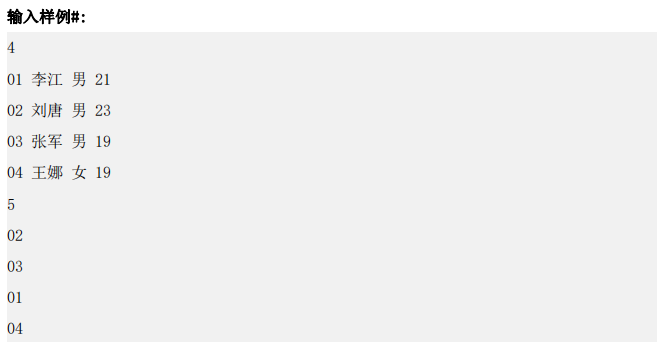
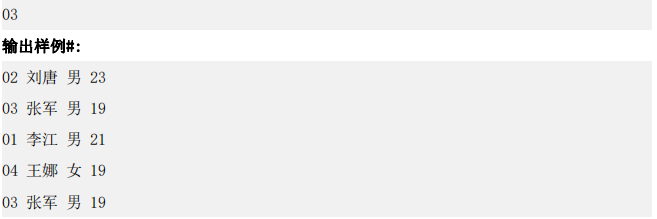
对于查询量大的题目,我们有两种方法:一是将学号先排好序,然后使用二分查找,但是很多同学写二分的时候容易出现问题,而且代码量也比较大,不太推荐这种做法。二是使用map,推荐大家使用这种方法,基本上 map 可以通过 99.9%的这类题目。
cpp
#include <bits/stdc++.h>
using namespace std;
struct node{
string num;
string name;
string sex;
int age;
};
int main(){
int n,q;
map<string, node> M;//定义一个 map 映射
while(scanf("%d", &n)!=EOF){
for(int i=0;i<n;i++){
node tmp;
cin>>tmp.num>>tmp.name>>tmp.sex>>tmp.age;
M[tmp.num] = tmp;//将学号指向对应的结构体
}
scanf("%d", &q);
for(int i=0;i<q;i++){
string num;
cin>>num;
if((M.find(num))!=M.end())//find 查找 如果找不到则返回末尾
cout<<M[num].num<<" "<<M[num].name<<" "<<M[num].sex<<" "<<M[num].age<<endl;
else
cout<<"No Answer!"<<endl;
}
}
return 0;
}上边是静态查找,接下来我们看一道动态查找的问题:
🥥例题:DreamJudge 1477

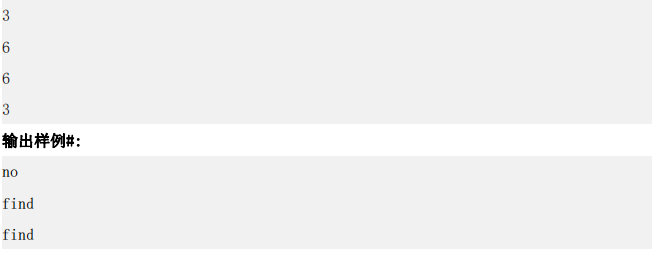
分析这道题目,这道题的一大特点就是,数的集合在不断的改变。如果用先排序再二分的方法就会很困难,因为加入新的数时需要去多次移动数组才能将数插进去,最坏情况每次插入都是 O(n)的复杂度,这是无法接受的。当然也不是说不能用这样的方法来解决,可以用离线的方法来解决这个问题,但是这样做太复杂,不适合在考试中使用。那么我们考虑用 map 来解决这个问题。
cpp
#include <bits/stdc++.h>
using namespace std;
int main(){
int n,q,x;
map<int, int> M;//定义一个 map 映射
scanf("%d", &n);
for (int i = 0; i < n; i++) {
scanf("%d", &x);
M[x]++;//记录集合中 x 有多少个
}
scanf("%d", &q);
for (int i = 0; i < q; i++) {
scanf("%d", &x);
if (M[x] == 0) {//如果 x 的个数为 0
printf("no\n");
M[x]++;//将 x 加入到集合中
}
else printf("find\n");
}
return 0;
}接下来还是说说二分这个方法,二分的前提是单调性,只要满足单调性就可以二分,不论是单个元素还是连续区间。下面给出二分的代码供参考:
cpp
#include <bits/stdc++.h>
using namespace std;
int a[10005];
int main(){
int n,x;
scanf("%d", &n);//输入 n 个数
for (int i = 1; i <= n; i++) {
scanf("%d", &a[i]);
}
sort(a+1, a+1+n);//排序保持单调性
scanf("%d", &x);//要查找的数 x 13. int l = 1, r = n;
while (l <= r) {
int mid = (l + r) / 2;
if (a[mid] == x) {
printf("find\n");
return 0;
}
if (a[mid] > x) {//如果 x 比中间数小
r = mid - 1;//说明在左区间
}
else l = mid + 1;//否则在右区间内
}
printf("not find\n");
return 0;
}🥥练习题目:
DreamJudge 1177 查找学生信息
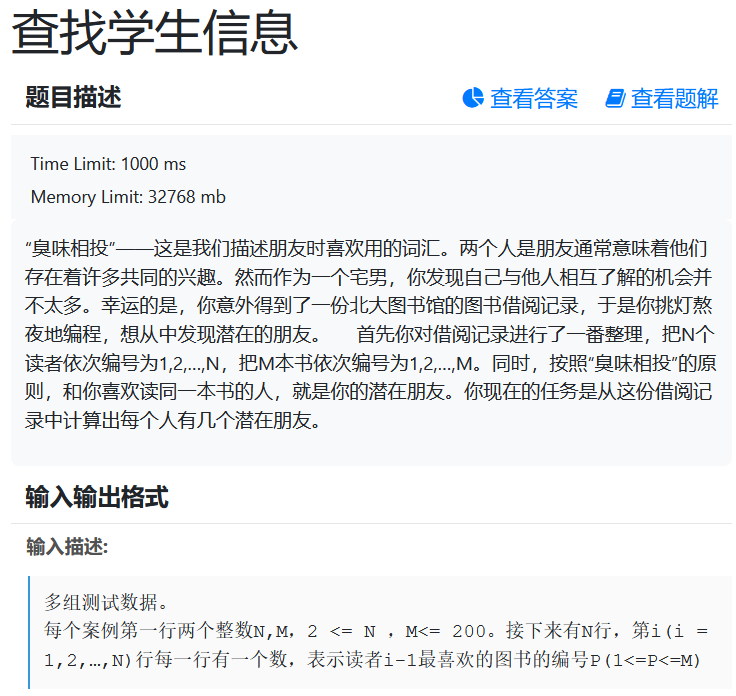

这道题目其实不用map,直接使用两个数组,一个数组记录每个人借阅了哪本书,另一个数组记录每本书的借阅情况,然后查找即可。
cpp
#include<bits/stdc++.h>
using namespace std;
int main()
{
int n,m;
while(cin>>n>>m)
{
vector<int> a(n+5),b(m+5);
for(int i=1;i<=n;i++)
{
cin>>a[i];
b[a[i]]++;
}
for(int i=1;i<=n;i++)
{
if(b[a[i]]-1) cout<<b[a[i]]-1<<endl;
else cout<<"BeiJu"<<endl;
}
}
return 0;
}DreamJudge 1388 查找 1
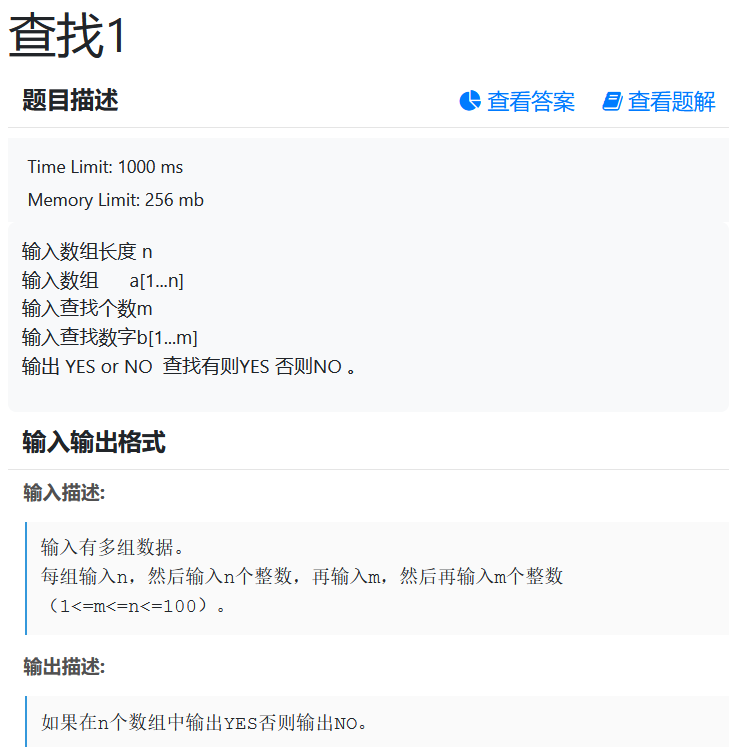

这道题目用不到map,因为只需要记录一个数据,直接使用set进行查找即可,也是用find进行查找,如果需要记录二维信息,那么用map。
cpp
#include<bits/stdc++.h>
using namespace std;
int main()
{
int n,m;
while(cin>>n)
{
set<int> s;
int cur;
for(int i=0;i<n;i++)
{
cin>>cur;
s.insert(cur);
}
cin>>m;
for(int i=0;i<m;i++)
{
cin>>cur;
if(s.find(cur)!=s.end()) cout<<"YES"<<endl;
else cout<<"NO"<<endl;
}
}
return 0;
}DreamJudge 1387 查找 - 北邮 🍰
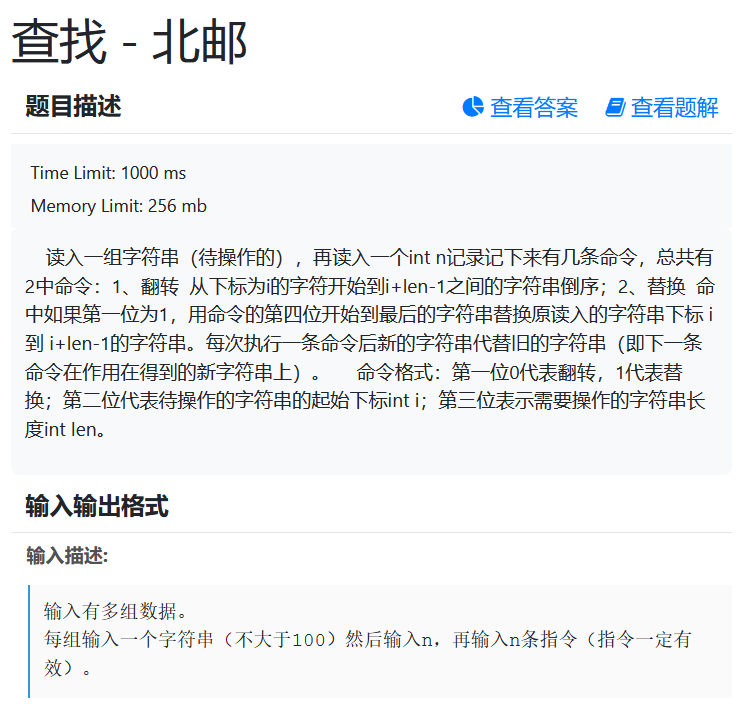
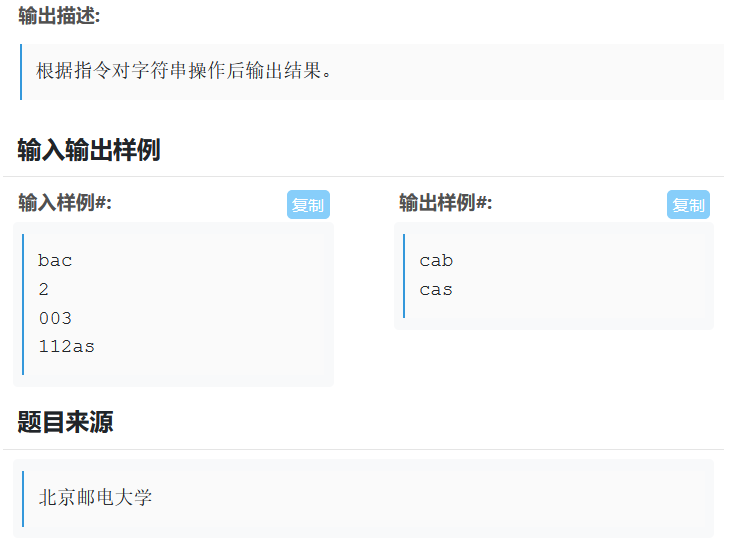
cpp
#include<iostream>
#include<string>
using namespace std;
string s;
int n;
void pd1(int i,int len)
{
int left=i,right=i+len-1;//翻转范围
for (int j=1;j<=len/2;j++)
{
char tmp=s[left];
s[left]=s[right];
s[right]=tmp;
left++;
right--;
}
}
int main()
{
while(cin>>s)
{
cin>>n;
while(n--)
{
string op;
cin>>op;
int i=op[1]-'0';
int len=op[2]-'0';
if(op[0]-'0'==0) pd1(i,len);
else
{
string rep=op.substr(3,op.size());
s.erase(i,len);
s.insert(i,rep);
}
cout<<s<<endl;
}
}
return 0;
}DreamJudge 1383 查找第 K 小数
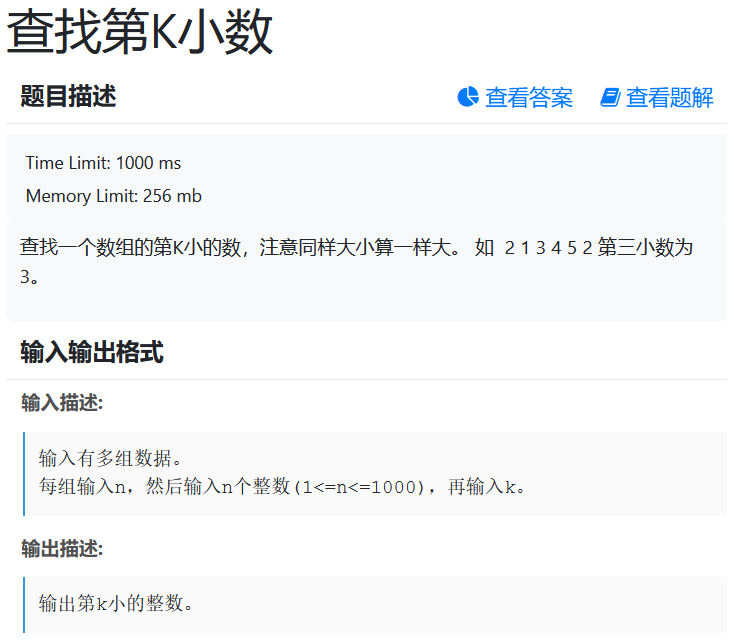
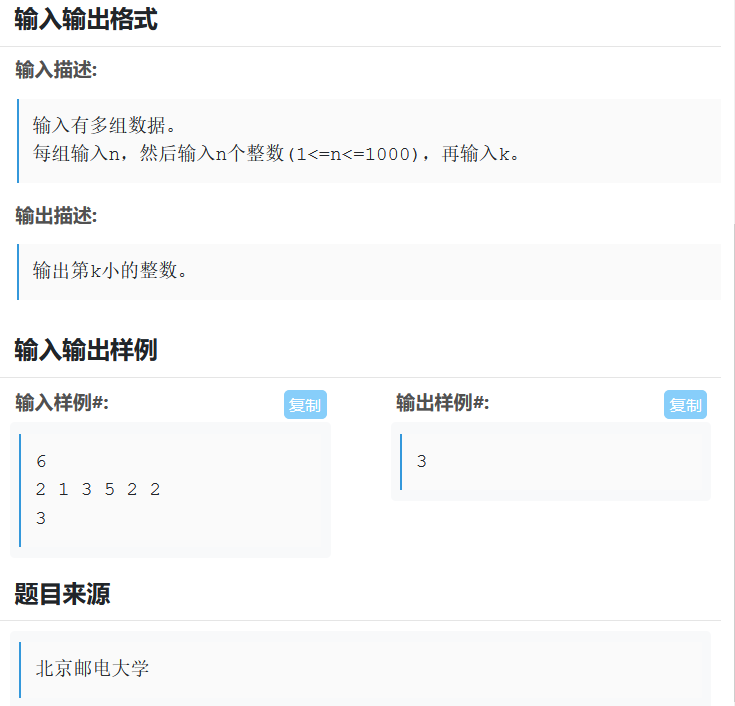
cpp
#include<bits/stdc++.h>
using namespace std;
int main()
{
int n,k,cur;
set<int> s;
while(cin>>n)
{
for(int i=0;i<n;i++)
{
cin>>cur;
s.insert(cur);
}
cin>>k;
k--;
auto it=s.begin();
while(k--) it++;
cout<<*it<<endl;
}
return 0;
}🧊🧊🧊2.8 贪心类问题
贪心算法更重要的是一种贪心的思想,它是通过当前最优解,得到全局最优解。
我们先通过几个例子感受一下贪心思想:
例子 1:地上有 3 张纸币,分别是 5 元、1 元和 10 元,问你只能拿一张,最多能拿多少钱?
解析:很明显,10 元。
例子 2:地上有 n 张纸币,有 1 元的,有 5 元的,还要 10 元的,问你只能拿一张,最多能拿多少钱?
解析:很明显,还是 10 元。
例子 3:地上有很多纸币,有 a 张 1 元的,有 b 张 5 元的,还要 c 张 10 元的,问你从中拿x张,最多能拿多少钱?
解析:大家应该都能想到,肯定是优先拿 10 元的,如果 10 元的拿完了,再拿 5 元的,最后才会拿 1 元的。这就是贪心的思想,所以贪心其实是很容易想到的。
例子 4:有 n 个整数构成的集合,现在从中拿出 x 个数来,问他们的和最大能是多少?
解析:相信大家都能想到,优先拿大的,从大到小一个个拿,这样组成的和最大。那么在解决这个问题之前,我们需要先排序,从大到小的排好序,然后将前 x 个数的和累加起来就是答案。
使用贪心时,往往需要按照某个特性先排好序,所以贪心一般和sort、堆等一起使用。
🥥例题:DreamJudge 1478
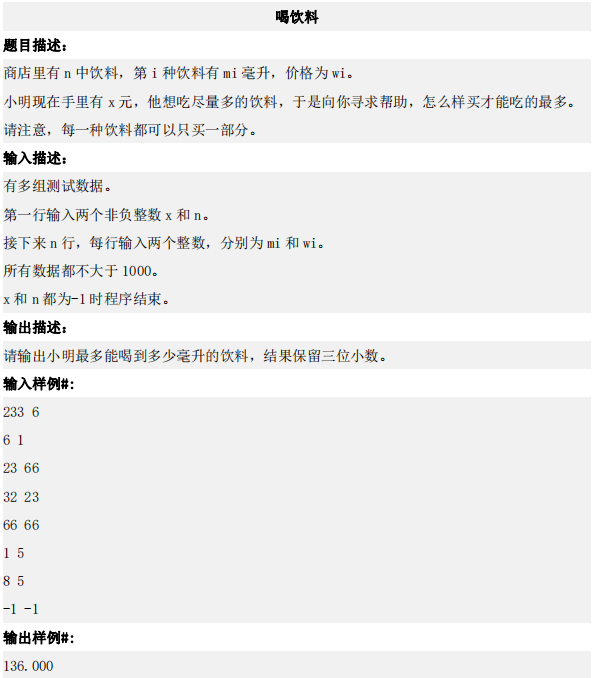
通过分析可以发现,小明想要喝尽量多的饮料,肯定优先选择性价比最高的饮料喝,也就是说先喝1毫升的价格最低的饮料,所以就需要去比较每种饮料1毫升的价格是多少,按照这个单价从低到高依次排序,然后一个一个往后喝,这样可以保证小明能喝到最多的饮料。
cpp
#include <bits/stdc++.h>
using namespace std;
struct node {
double w, m;
}p[1005];
bool cmp(node a, node b) {
//按照每毫升的价格从低到高排序
return a.w/a.m < b.w/b.m;
}
int main(){
int n,x;
while (scanf("%d%d", &x, &n) != EOF) {
if (x == -1 && n == -1) break;
for (int i = 1; i <= n; i++) {
scanf("%lf%lf", &p[i].m, &p[i].w);
}
sort(p+1, p+1+n, cmp);
double ans = 0;
for (int i = 1; i <= n; i++) {
if (x >= p[i].w) {//如果剩余的钱能全买
ans += p[i].m;
x -= p[i].w;
}
else {//如果剩余的钱买不完这种饮料
ans += (p[i].m*x/p[i].w);
break;//到这里 x 已经为 0 了
}
}
printf("%.3lf\n", ans);
}
return 0;
}🥥题型总结:
贪心题目看起来简单但做起来难的原因原因有二:一是就没有想到这个题目应该用贪心算法,没能将题目抽象成数学模型来分析。二是读懂题了,知道应该用贪心算法解题,但排序的特征点没有找准,因为不是所有题目都能明显看出从小到大排序,有的题目可能隐藏的比较深,但是这种难度的贪心不常见。所以机试中的贪心题,只要反应过来是用贪心,99%的情况下都能解决。
🥥练习题目:
DreamJudge 1307 组队刷题 🍰

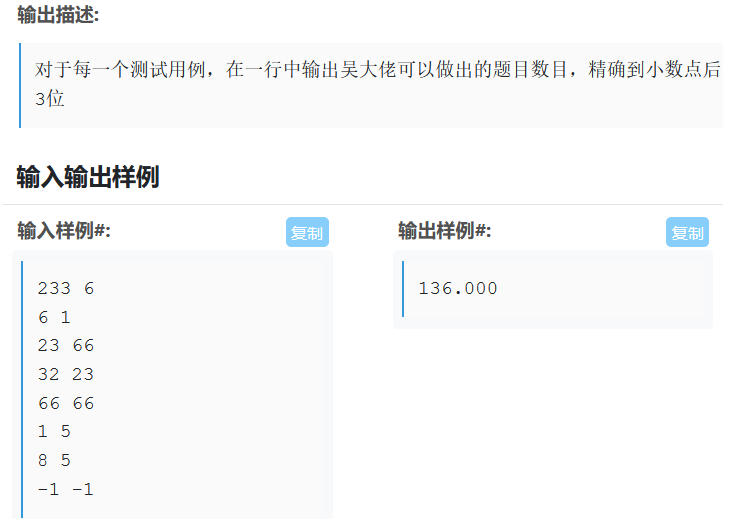
cpp
#include<bits/stdc++.h>
using namespace std;
struct node
{
double w;//题目
double m;//精力
}a[200];
bool cmp(node a,node b){ return a.w/a.m>b.w/b.m;}
int main()
{
int m,n;
while(cin>>m>>n)
{
if(m==-1&&n==-1)
break;
for(int i=0;i<n;i++) cin>>a[i].w>>a[i].m;
sort(a,a+n,cmp);
double cnt=0;
for(int i=0;i<n;i++)
{
if(m>a[i].m)
{
m-=a[i].m;
cnt+=a[i].w;
}
else
{
cnt+=m/a[i].m*a[i].w;
break;
}
}
printf("%.3lf\n",cnt);//用cout<<fixed<<setpercision(3)<<cnt会超时
}
return 0;
}DreamJudge 1347 To Fill or Not to Fill 🍰

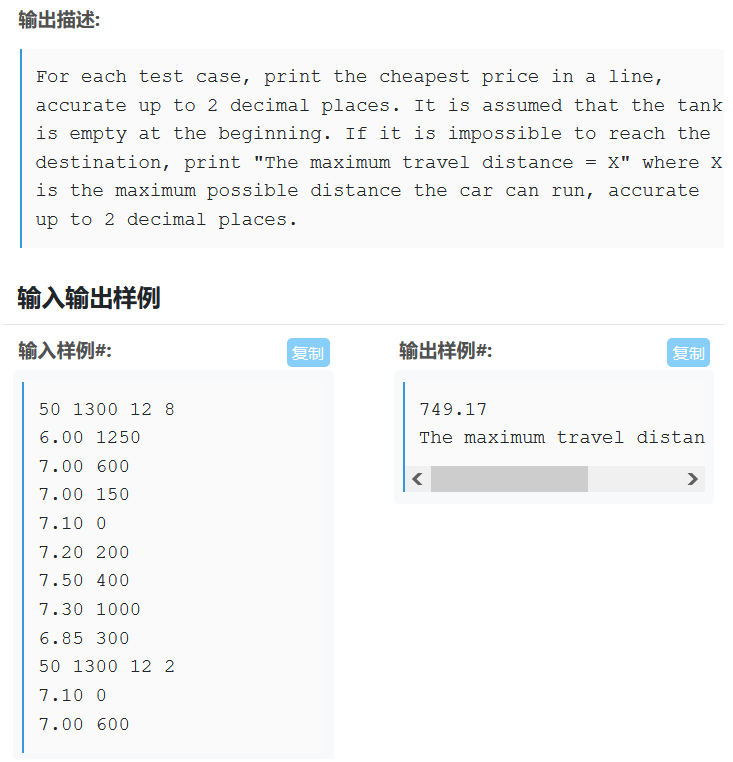
输出:
749.17
The maximum travel distance = 1200.00
cpp
/*
摘自N诺评论区大神:mimicool
我们假设会经过所有的加油站
我们可以假装持有价格高得油,一旦遇到价格低的就进行替换
在经过加油站的时候,我们补充该加油站的油(注意是假设补充,具体是否补充要看之后有没有遇见更加便宜的油)比如,我们的油箱在遇到价值4快的加油站时,还剩下2块钱的油和5块钱的油,这说明之前假装补充的5块钱的油是可以被四块钱的油所替代,因此我们就可以补充油注意计算cost的时候要以实际花费的油为准,而不是在补充油的时候进行计算
*/
#include<bits/stdc++.h>
using namespace std;
// double判断相等需要用一个接近无穷小
#define eps 1e-8
//加油站结构体
struct Station{
double price, distance;
}s[200];
bool cmp(Station s1, Station s2){
return s1.distance < s2.distance;
}
int main(){
double cmax, d, davg;
int n;
while (scanf("%lf%lf%lf%d", &cmax, &d, &davg, &n) != EOF){
// 从1开始,较为清晰
for (int i = 1; i <= n; i++){
scanf("%lf%lf", &s[i].price, &s[i].distance);
}
//终点看作特殊的加油站
s[n+1].distance = d;
s[n+1].price = 0;
//注意这里的上下界
sort(s+1, s+1+n+1, cmp);
//双端队列,一方面弹出最低价格的油作为消耗;另一方面弹出最高价格的油作为替换
deque<pair<double, double>> d;
double sumdis = 0., cost = 0.;
if (s[1].distance > eps) printf("The maximum travel distance = 0.00\n");
else {
d.push_back(make_pair(s[1].price, cmax));
for (int i = 2; i <= n+1; i++){
//目标第i个加油站
double sdis = s[i].distance - s[i-1].distance; //距离目标加油站的距离
double need = sdis / davg; //需要使用的油
//printf("%d, %lf, %lf\n", i, sdis, need);
if (need-cmax > eps){
//油不够用
sumdis += cmax*davg;
printf("%s%.2lf", "The maximum travel distance = ", sumdis);
break;
}else{
//油够用
sumdis += sdis;
//add是最后要添加的油,计算过程:使用的油+高价的油
double add = need;
while (need > eps){
//这部分是用来计算cost和更新队列原有油信息的
if (d.front().second-need > eps){
//需求小于价格最低的油量,意味着无需弹出队列
cost += need*d.front().first;
d.front().second -= need;
need = 0;
}else {
//需求大于价格最低的油量,意味着需要弹出队列并进行循环
cost += d.front().first*d.front().second;
need -= d.front().second;
d.pop_front();
}
}
while(!d.empty() && d.back().first > s[i].price){
//这部分使用while循环遍历,找出所有高价油弹出
add += d.back().second;
d.pop_back();
}
//用当前加油站油替换
d.push_back(make_pair(s[i].price, add));
}
//如果此时到达了终点,就打印cost
if (i == n+1) printf("%.2lf\n", cost);
}
}
}
return 0;
}🧊🧊🧊2.9 链表类问题
链表类问题属于选读章节,对于使用 OJ 测评的院校的同学来说,这类问题可以用数组来实现,没有必要用链表去实现,慢且易出错,所以一般都直接用数组实现,反正最后能 AC 就行,这部分同学跳过本节或仅做了解即可。但是对于非 OJ 测评的院校来说,链表类问题可以说是必考的题型。
🥥题型总结:
- **猴子报数:**循环链表建立之后,按照题意删除节点。
- **两个有序链表合并为一个:**这个和两个有序数组合并为一个有序数组原理一样。
- **链表排序:**使用冒泡排序进行链表排序,因为冒泡排序是相邻两个元素进行比较交换,适合链表。
🥥例题:DreamJudge 1081
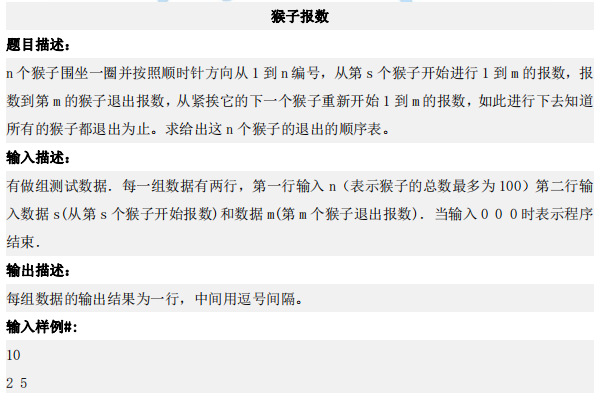

需要创建一个首尾相连的循环链表,先走 s 步,再开始循环遍历链表,每走 m 步删除一个节点,直到链表中只剩下一个节点时结束循环。只剩一个节点的判断条件是,它的下一个指针指向的是自己,说明自循环了。
cpp
#include <stdio.h>
#include <malloc.h>
struct node {
int num;
struct node *next;
};
int n, s, m;
//创建循环链表
struct node* create() {
struct node *head, *now, *pre;
for (int i = 1; i <= n; i++) {
now = (struct node *)malloc(sizeof(node));
if (i == 1) {
head = now;
pre = now;
}
now->num = i;
now->next = head;
pre->next = now;
pre = now;
}
return head;
};
//按照题目要求输出
void print(struct node *head) {
struct node *p, *pre;//pre 是前一个节点
p = head;
s -= 1;//因为起点在第一个 所以要少走一步
while (s--) {//先走 s 步
pre = p;
p = p->next;
}
int i = 1;
while (p != NULL) {
if (p == p->next) {//只剩最后一个
printf("%d\n", p->num);
break;
}
if (i % m == 0) {//找到第 m 个
printf("%d,", p->num);//输出它
pre->next = p->next;//删除它
}
else pre = p;//这里一定要用 else 如果是删除的话 pre 不变
p = p->next;
i++;
}
}
int main(){
while (scanf("%d%d%d", &n, &s, &m) != EOF) {
if (n==0&&s==0&&m==0) break;
struct node *head;
head = create();
print(head);
}
return 0;
}🥥练习题目:
DreamJudge 1015 单链表
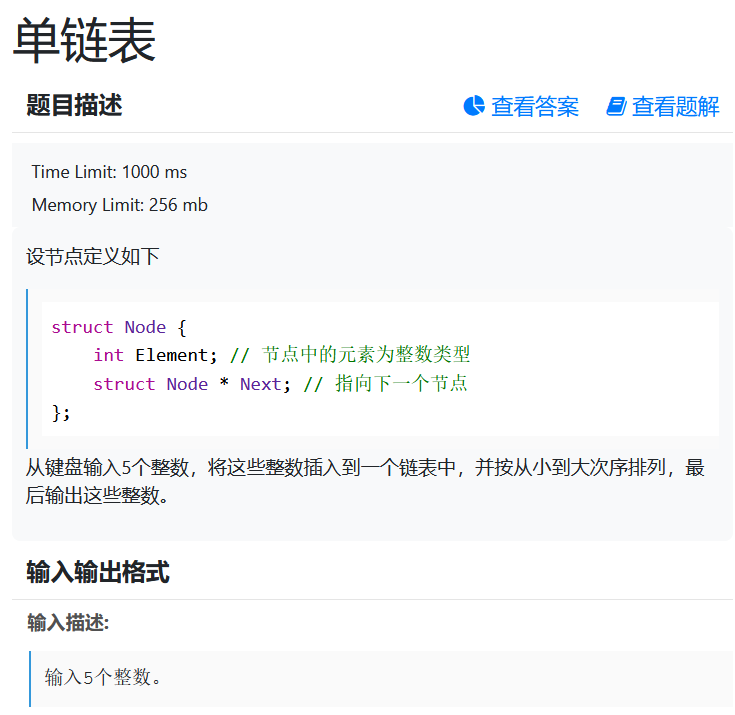
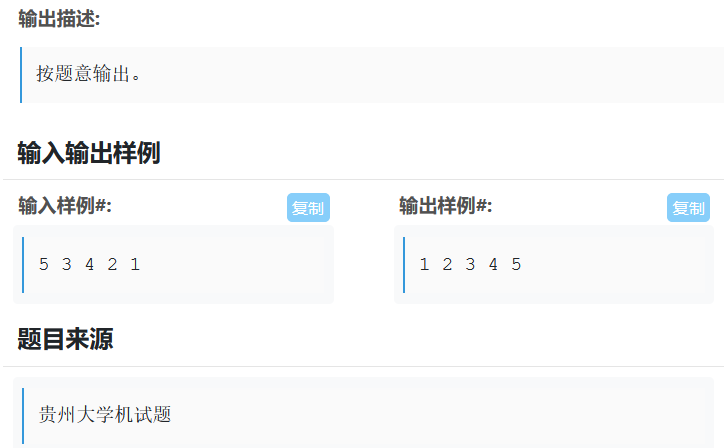
cpp
#include<bits/stdc++.h>
using namespace std;
int main()
{
int a[10]={0};
for(int i=0;i<5;i++) cin>>a[i];
sort(a,a+5);
for(int i=0;i<5;i++) cout<<a[i]<<" ";
return 0;
}DreamJudge 1018 击鼓传花
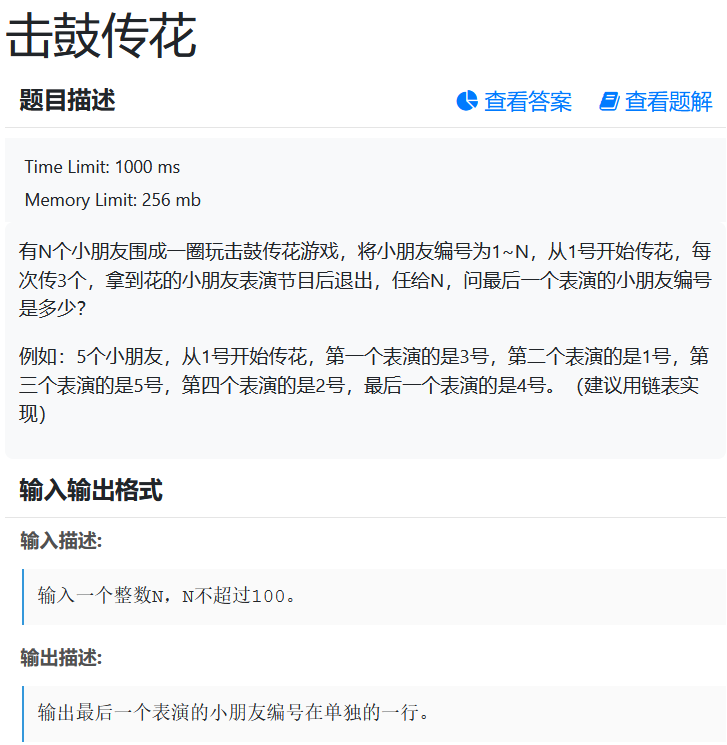

cpp
#include<bits/stdc++.h>
using namespace std;
int main()
{
int n;
cin>>n;
queue<int> q;
int cur;
for(int i=1;i<=n;i++) q.push(i);
while(!q.empty())
{
for(int i=0;i<2;i++)
{
int c=q.front();
q.pop();
q.push(c);
}
cur=q.front();
q.pop();
}
cout<<cur;
return 0;
}DreamJudge 1025 合并链表
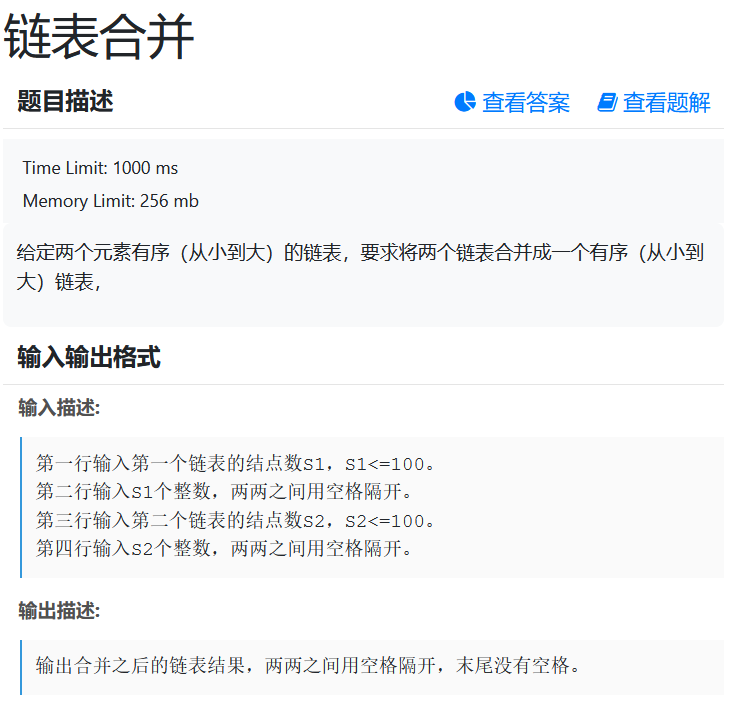
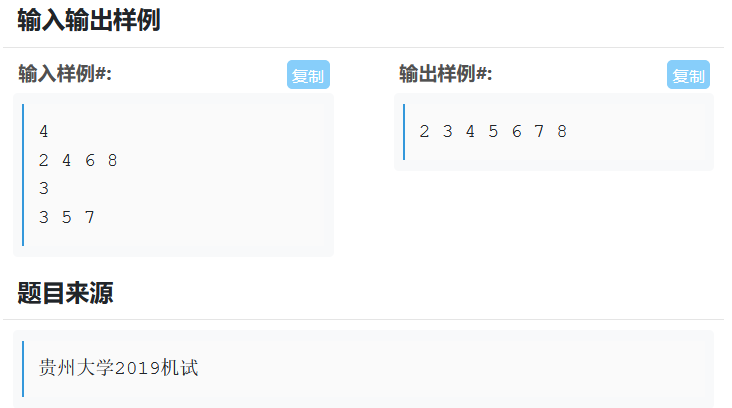
cpp
#include<bits/stdc++.h>
using namespace std;
int main()
{
vector<int> a;
int n,m,cur;
cin>>n;
for(int i=0;i<n;i++)
{
cin>>cur;
a.push_back(cur);
}
cin>>m;
for(int i=0;i<m;i++)
{
cin>>cur;
a.push_back(cur);
}
sort(a.begin(),a.end());
for(int i=0;i<n+m;i++) cout<<a[i]<<" ";
return 0;
}DreamJudge 1405 遍历链表
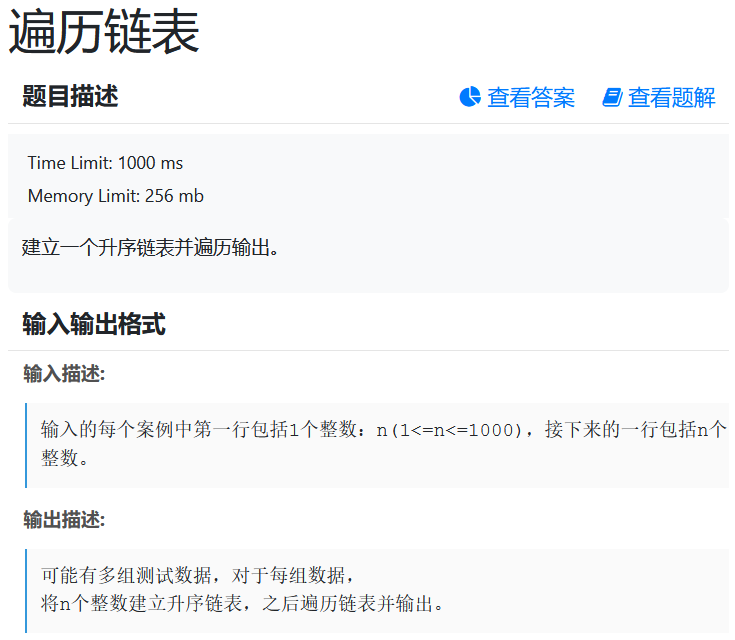
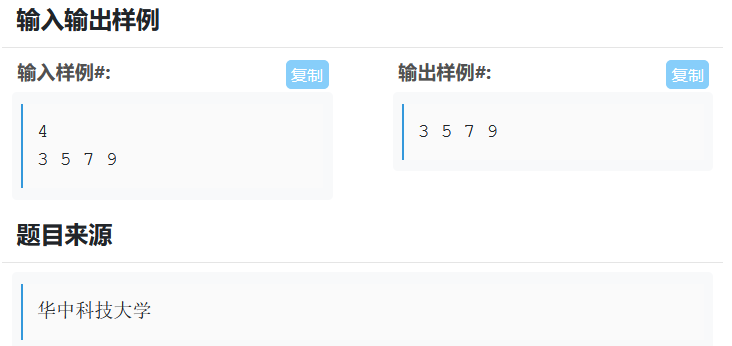
cpp
#include<bits/stdc++.h>
using namespace std;
int main()
{
int n,a[1010]={0};
cin>>n;
for(int i=0;i<n;i++) cin>>a[i];
sort(a,a+n);
for(int i=0;i<n;i++) cout<<a[i]<<" ";
return 0;
}创作不易,点个赞吧~点赞收藏不迷路,感兴趣的宝子们欢迎关注该专栏~
这部分的练习题特别多,我后边会尽快补齐的,做完我就更新啦,大家可以先自己练习着~
勤奋努力的宝子们,学习辛苦了!🌷🌷🌷休息下,我们下部分再见👋( •̀ ω •́ )✧~